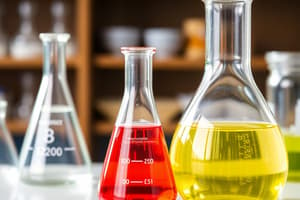Podcast
Questions and Answers
What is the study of motion and forces known as?
What is the study of motion and forces known as?
- Electromagnetism
- Classical Mechanics (correct)
- Quantum Mechanics
- Thermodynamics
Which type of chemical bond involves the sharing of electron pairs between atoms?
Which type of chemical bond involves the sharing of electron pairs between atoms?
- Metallic Bond
- Ionic Bond
- Covalent Bond (correct)
- Hydrogen Bond
What concept describes the variability of a species' traits over generations?
What concept describes the variability of a species' traits over generations?
- Genetic drift
- Gene flow
- Genetics
- Natural selection (correct)
In thermochemistry, which type of reaction releases heat into the surroundings?
In thermochemistry, which type of reaction releases heat into the surroundings?
Which part of speech describes an action or state of being?
Which part of speech describes an action or state of being?
What fundamental unit of life is characterized by its cellular structure and functions?
What fundamental unit of life is characterized by its cellular structure and functions?
Which principle states that measuring one property in a quantum system constrains the measurement of another property?
Which principle states that measuring one property in a quantum system constrains the measurement of another property?
Which law in thermodynamics states that energy cannot be created or destroyed?
Which law in thermodynamics states that energy cannot be created or destroyed?
Flashcards are hidden until you start studying
Study Notes
Physics
- Classical Mechanics: Study of motion and forces.
- Newton's laws of motion.
- Concepts of energy and momentum.
- Thermodynamics: Relationship between heat and other forms of energy.
- Laws of thermodynamics.
- Concepts of entropy and enthalpy.
- Electromagnetism: Study of electric and magnetic fields.
- Maxwell's equations.
- Concepts of voltage, current, and resistance.
- Quantum Mechanics: Behavior of matter and energy on atomic and subatomic levels.
- Wave-particle duality.
- The uncertainty principle.
Chemistry
- Atomic Structure: Basics of atoms and their components.
- Protons, neutrons, electrons.
- Atomic number and mass.
- Chemical Bonding: How atoms connect to form molecules.
- Ionic, covalent, and metallic bonds.
- Molecular geometry and polarity.
- Stoichiometry: Quantitative relationships in chemical reactions.
- Balancing equations.
- Molar mass and conversions.
- Thermochemistry: Study of heat changes in chemical reactions.
- Exothermic and endothermic reactions.
- Calorimetry techniques.
Biology
- Cell Biology: Structure and function of cells.
- Prokaryotic vs. eukaryotic cells.
- Organelles and their functions.
- Genetics: Study of heredity and variation in organisms.
- Mendelian genetics.
- DNA structure and replication.
- Evolution: Mechanisms of evolution and natural selection.
- Evidence of evolution (fossil records, comparative anatomy).
- The role of genetic drift and gene flow.
- Ecology: Interactions between organisms and their environment.
- Ecosystems and biomes.
- Food webs and energy flow.
English
- Grammar: Rules governing sentence structure.
- Parts of speech (nouns, verbs, adjectives, etc.).
- Sentence types (declarative, interrogative, imperative).
- Literature: Study of written works.
- Genres (fiction, poetry, drama).
- Key literary devices (metaphor, symbolism, irony).
- Writing Skills: Effective communication in written form.
- Structure of essays (introduction, body, conclusion).
- Importance of thesis statements and evidence.
Hindi
- Grammar: Basics of Hindi grammar.
- Nouns, pronouns, verbs, and their conjugations.
- Sentence structure and word order.
- Literature: Important works and authors in Hindi literature.
- Poets like Surdas, Tulsidas.
- Modern writers like Harivansh Rai Bachchan.
- Writing and Composition: Skills for effective communication.
- Importance of clarity and coherence.
- Different forms of writing (essays, stories, letters).
Classical Mechanics
- Newton's three laws of motion govern the relationship between a body and the forces acting upon it, and its motion in response to those forces.
- Energy, the capacity to do work, exists in various forms (kinetic, potential, etc.) and is conserved in closed systems.
- Momentum, a measure of mass in motion, is also conserved in the absence of external forces.
Thermodynamics
- The First Law of Thermodynamics states that energy cannot be created or destroyed, only transformed.
- The Second Law of Thermodynamics describes the increase of entropy (disorder) and irreversibility in natural processes.
- Enthalpy represents the total heat content of a system at constant pressure.
Electromagnetism
- Maxwell's equations unify electricity and magnetism, describing their interactions and the propagation of electromagnetic waves.
- Voltage is the electrical potential difference between two points. Current is the flow of electric charge. Resistance opposes the flow of current.
Quantum Mechanics
- Wave-particle duality describes the ability of matter to exhibit properties of both waves and particles.
- The Heisenberg Uncertainty Principle states that it is impossible to simultaneously know both the position and momentum of a particle with perfect accuracy.
Atomic Structure
- Atoms consist of protons (positive charge), neutrons (neutral charge), and electrons (negative charge).
- Atomic number represents the number of protons, defining an element's identity. Mass number is the sum of protons and neutrons.
Chemical Bonding
- Ionic bonds result from the electrostatic attraction between oppositely charged ions.
- Covalent bonds involve the sharing of electrons between atoms.
- Metallic bonds arise from the delocalized electrons in a metal lattice.
Stoichiometry
- Balanced chemical equations represent the quantitative relationships between reactants and products.
- Molar mass is the mass of one mole (6.022 x 1023) of a substance.
Thermochemistry
- Exothermic reactions release heat to their surroundings, while endothermic reactions absorb heat.
- Calorimetry techniques measure the heat changes in chemical reactions.
Cell Biology
- Prokaryotic cells lack a nucleus and membrane-bound organelles, while eukaryotic cells possess both.
- Organelles like mitochondria (energy production) and the endoplasmic reticulum (protein synthesis) perform specialized functions.
Genetics
- Mendelian genetics explains inheritance patterns based on the segregation and independent assortment of genes.
- DNA’s double helix structure carries the genetic code, directing protein synthesis and inheritable traits.
Evolution
- Natural selection favors individuals with advantageous traits, leading to adaptation and speciation.
- Fossil records, comparative anatomy, and molecular biology provide evidence for evolution.
Ecology
- Ecosystems consist of all living organisms (biotic factors) and their physical environment (abiotic factors) in a specific area.
- Food webs illustrate the complex feeding relationships within ecosystems.
Grammar (English & Hindi)
- English and Hindi grammars both utilize nouns, verbs, adjectives, etc., but their structures and rules differ significantly. Both languages have various sentence structures.
Literature (English & Hindi)
- Both English and Hindi literature encompass diverse genres (fiction, poetry, drama) and literary devices (metaphor, symbolism).
- Knowledge of significant authors and works is crucial for understanding literary movements and cultural contexts in both languages.
Writing Skills (English & Hindi)
- Effective writing in both languages necessitates clarity, coherence, and appropriate structure (e.g., essay format).
- Different writing forms (essays, stories, letters) require specific approaches and stylistic choices.
Studying That Suits You
Use AI to generate personalized quizzes and flashcards to suit your learning preferences.




